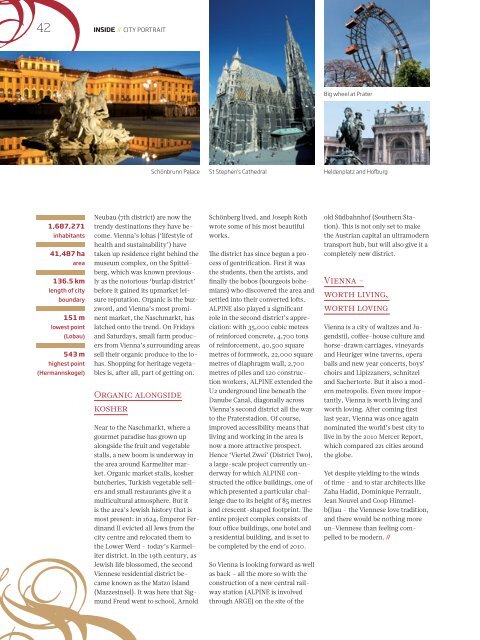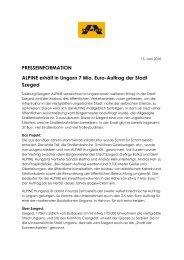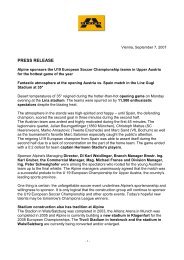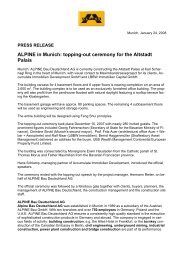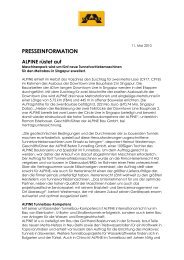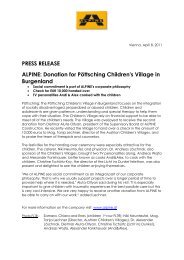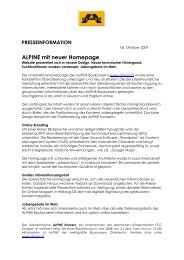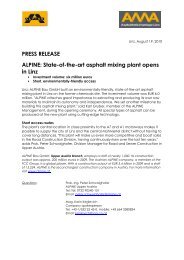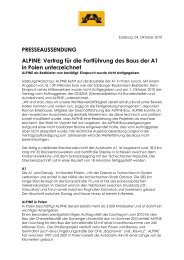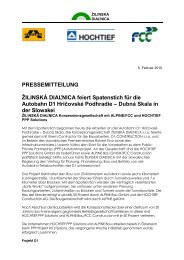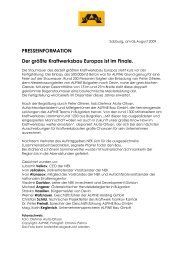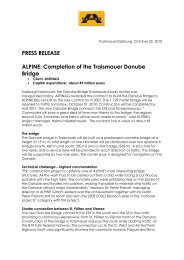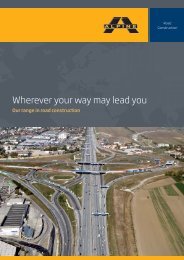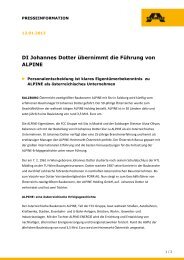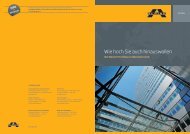DAM IMPRESSIVE
DAM IMPRESSIVE
DAM IMPRESSIVE
Create successful ePaper yourself
Turn your PDF publications into a flip-book with our unique Google optimized e-Paper software.
42 // CITY PORTRAIT<br />
1,687,271<br />
inhabitants<br />
41,487 ha<br />
area<br />
136.5 km<br />
length of city<br />
boundary<br />
151 m<br />
lowest point<br />
(Lobau)<br />
543 m<br />
highest point<br />
(hermannskogel)<br />
Neubau (7th district) are now the<br />
trendy destinations they have become.<br />
Vienna’s lohas (‘lifestyle of<br />
health and sustainability’) have<br />
taken up residence right behind the<br />
museum complex, on the Spittelberg,<br />
which was known previously<br />
as the notorious ‘burlap district’<br />
before it gained its upmarket leisure<br />
reputation. Organic is the buzzword,<br />
and Vienna’s most prominent<br />
market, the Naschmarkt, has<br />
latched onto the trend. On Fridays<br />
and Saturdays, small farm producers<br />
from Vienna’s surrounding areas<br />
sell their organic produce to the lohas.<br />
Shopping for heritage vegetables<br />
is, after all, part of getting on.<br />
Organic alongside<br />
kosher<br />
Near to the Naschmarkt, where a<br />
gourmet paradise has grown up<br />
alongside the fruit and vegetable<br />
stalls, a new boom is underway in<br />
the area around Karmeliter market.<br />
Organic market stalls, kosher<br />
butcheries, Turkish vegetable sellers<br />
and small restaurants give it a<br />
multicultural atmosphere. But it<br />
is the area’s Jewish history that is<br />
most present: in 1624, Emperor Ferdinand<br />
II evicted all Jews from the<br />
city centre and relocated them to<br />
the Lower Werd – today’s Karmeliter<br />
district. In the 19th century, as<br />
Jewish life blossomed, the second<br />
Viennese residential district became<br />
known as the Matzo Island<br />
(Mazzesinsel). It was here that Sigmund<br />
Freud went to school, Arnold<br />
Schönbrunn Palace St Stephen’s Cathedral<br />
Schönberg lived, and Joseph Roth<br />
wrote some of his most beautiful<br />
works.<br />
The district has since begun a process<br />
of gentrification. First it was<br />
the students, then the artists, and<br />
finally the bobos (bourgeois bohemians)<br />
who discovered the area and<br />
settled into their converted lofts.<br />
ALPINE also played a significant<br />
role in the second district’s appreciation:<br />
with 35,000 cubic metres<br />
of reinforced concrete, 4,700 tons<br />
of reinforcement, 40,500 square<br />
metres of formwork, 22,000 square<br />
metres of diaphragm wall, 2,700<br />
metres of piles and 120 construction<br />
workers, ALPINE extended the<br />
U2 underground line beneath the<br />
Danube Canal, diagonally across<br />
Vienna’s second district all the way<br />
to the Praterstadion. Of course,<br />
improved accessibility means that<br />
living and working in the area is<br />
now a more attractive prospect.<br />
Hence ‘Viertel Zwei’ (District Two),<br />
a large-scale project currently underway<br />
for which ALPINE constructed<br />
the office buildings, one of<br />
which presented a particular challenge<br />
due to its height of 85 metres<br />
and crescent-shaped footprint. The<br />
entire project complex consists of<br />
four office buildings, one hotel and<br />
a residential building, and is set to<br />
be completed by the end of 2010.<br />
So Vienna is looking forward as well<br />
as back – all the more so with the<br />
construction of a new central railway<br />
station (ALPINE is involved<br />
through ARGE) on the site of the<br />
Big wheel at Prater<br />
Heldenplatz and Hofburg<br />
old Südbahnhof (Southern Station).<br />
This is not only set to make<br />
the Austrian capital an ultramodern<br />
transport hub, but will also give it a<br />
completely new district.<br />
Vienna –<br />
worth living,<br />
worth loving<br />
Vienna is a city of waltzes and Jugendstil,<br />
coffee-house culture and<br />
horse-drawn carriages, vineyards<br />
and Heuriger wine taverns, opera<br />
balls and new year concerts, boys’<br />
choirs and Lipizzaners, schnitzel<br />
and Sachertorte. But it also a modern<br />
metropolis. Even more importantly,<br />
Vienna is worth living and<br />
worth loving. After coming first<br />
last year, Vienna was once again<br />
nominated the world’s best city to<br />
live in by the 2010 Mercer Report,<br />
which compared 221 cities around<br />
the globe.<br />
Yet despite yielding to the winds<br />
of time – and to star architects like<br />
Zaha Hadid, Dominique Perrault,<br />
Jean Nouvel and Coop Himmelb(l)au<br />
– the Viennese love tradition,<br />
and there would be nothing more<br />
un-Viennese than feeling compelled<br />
to be modern. //


